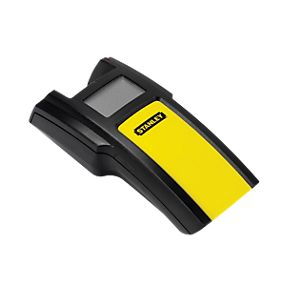Knowing how to find wall studs is important when hanging a heavy mirror, putting up shelves, or attaching large fixtures to a partition wall. Fixing heavy items into one of the wooden beams that make up the structure of the wall is far more secure than fixing into the plasterboard alone.
There are several methods you can use for finding wall studs in a partition wall, depending on what tools you have to hand.
Common Wall Stud Spacing
In the UK, wall studs are usually spaced at 400mm or 600mm intervals. If you have built the wall yourself, you should know which measurement was used and will be able to work out where the studs are located. If the wall is part of the original house or was built by a previous owner, the spacing will not be so certain.
A good rule to follow is to begin looking for wall studs 400-600mm away from the end of the wall, or where the partition wall meets any other wall.
1. Using an Electronic stud finder
This is certainly the easiest method of finding the positions of studs on your walls. An electronic stud finder works by measuring the relative density of the wall. Move it over a stud and it will display a higher density than when held over a cavity, even if filled with insulation material. Many modern stud finders can also be used to detect wiring and plumbing pipes in the wall.

To use an electronic stud finder, hold the sensor against the wall and slowly move it horizontally until it displays a higher density or beeps (depending on your device).
You can then mark the edge of the stud using a pencil. Run the sensor towards the mark from the opposite direction to find the other edge of the stud.
2. Using a Magnet or Magnetic Stud Finder
It is possible to buy magnetic stud finders relatively cheaply. These devices work by being attracted to the nails used to fix the plasterboards to the studs. You simply move the magnetic stud finder across the wall until it reacts to hidden metal nails. This method can be a little bit hit-and-miss and works best if you already have a rough idea of where the stud is located.
You can also do the same thing with any strong magnet. If you have a small, strong magnet laying around, you can attempt to use it to find the nails used to affix the plasterboard.
- Tie the magnet to a length of cotton or fishing line (or something similar) and let the magnet hang against the wall.
- Slowly move the magnet along the wall, holding the cotton so that it can swing freely.
- Repeat this at various heights across the wall until the magnet is attracted to something.
- Mark the position of the suspected nail and then move the magnet upwards and downwards from the mark to confirm a row of nails and the stud they are driven into.
3. Finding Studs without a Stud Finder
If you do not have access to a stud finder, there are still a few methods you can use to locate the studs.
a. Tapping and Drilling to Find Studs
The first is by tapping the wall at intervals and listening to the sound it makes. If you tap a stud, the knock should be deeper and sound less hollow. Using the smallest drill bit you have, drill a small hole at the bottom of the wall near the skirting board. If you hit wood, you have found a stud.
b. Measuring to Find Studs
If that sounds a bit too random, you can usually work out the rough location of a stud by measuring 400-600mm out from the end of the wall. Studs are usually spaced at one of these distances, so this should give you a pretty good idea of where the first stud is. Drill a small hole to confirm, and then you can continue to measure 400mm centers until in the area you want to affix something.
c. Using Other Fixtures to Find Studs
You can sometimes find the location of a stud by looking at any electrical sockets on the wall. In a stud or partition wall, the backplate of electrical sockets is often screwed into the side of a stud for strength. Tap the wall on either side of the socket and if the knock sounds dull, you have found a stud.
Choosing Plasterboard Fixings
If no stud is close to where you want to place the fitting or fixture, you may have to resort to fixing into the plasterboard itself. To do this, make sure you use the correct type of plasterboard fixing.
All plasterboard fixings are designed to do basically the same thing: Increase the area of plasterboard which is put under stress by the object hanging from it. However, not all of them do this in the same way and not all of them are suitable for all applications. A
s a general rule, use plastic or metal screw in fixings for light loads, plastic anchor or spring toggles for medium loads, and metal spring toggles for heavy loads. You can read more about plasterboard fixings in our complete guide.







